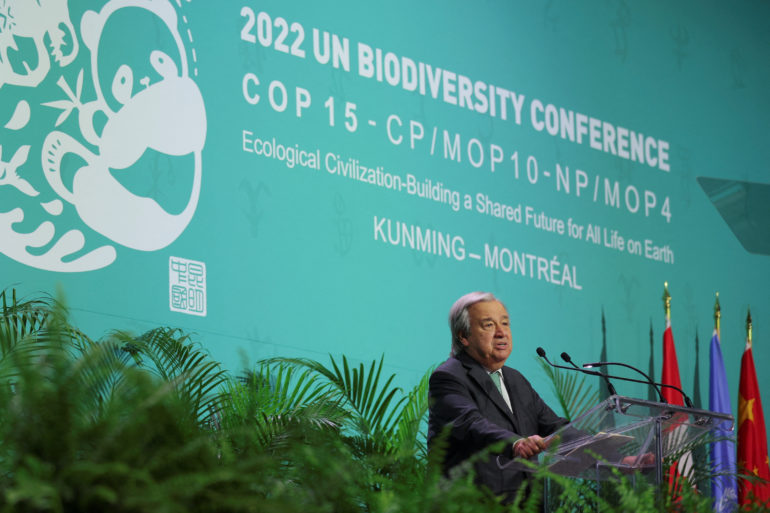Before the recent United Nations Biodiversity Conference in Montreal, the World Travel and Tourism Council, a nonprofit organization of travel businesses, issued a report on “nature positive travel,” a new term that describes travel that supports and protects nature.
Julia Simpson, the president and chief executive of the W.T.T.C., called the report “a big shout-out for nature.”
Alarmingly, the report notes that one in four species worldwide faces the threat of extinction (as assessed by the International Union for the Conservation of Nature), and that species abundance, the number of individuals of each species in a particular location, has fallen 68 percent since 1970, according to the World Wildlife Fund. To combat these declines, the report, which has been endorsed by the Secretariat of the U.N. Biodiversity Conference and the World Commission on Protected Areas, offers recommendations that include raising awareness of the importance of biodiversity among travelers; auditing travel companies and those that supply them for their impact on nature; collaborating with local communities as guardians of nature; and investing in species protection and habitat reconstruction.
While the W.T.T.C. has already published a road map to net-zero carbon emissions for the travel industry by 2050, Ms. Simpson calls nature positive tourism “a practical guide for our industry” to protect nature and encourage biodiversity while awaiting more powerful solutions to decarbonize travel, particularly aviation.
She recently answered questions on nature positive travel. The following are excerpts from the interview, edited for length and clarity.
What is the purpose of nature positive tourism?
As we’re seeing the devastating effects of climate change on our world, with horrendous fires and floods and tornadoes, everybody’s more and more aware of what we can do to lessen the impact. Earlier this year, we published the net zero road map for travel and tourism to reduce our impact in terms of carbon emissions by 50 percent by 2030. Biodiversity is the flip side of that. With nature positive tourism, we’re looking to protect and rebuild nature.
Eighty percent of all travel involves the traveler going into some form of nature. It could be a beach, it could be mangroves, it could be skiing, it could be mountaineering. We used to talk about leaving a lighter footprint. But now I think people actually want to have a positive footprint, like collecting plastics on the beaches of Bali that arrive there from other parts of the world.
For the travel and tourism industry overall, if threats to nature are poorly managed, they can contribute to all five recognized drivers of biodiversity loss, from changing land-use patterns to direct exploitation of resources, climate change, pollution and the introduction of invasive nonnative species.
The positive part of nature positive is actually doing something to improve an ecosystem as opposed to just being a benign force.
The report recommends reconnecting people to nature. How?
Some hotels in the tropics are connecting the consumer with the nature around them — often, even food will be sourced locally.
Nature positive tourism is also about connecting people within communities that can safeguard nature. For example, in Colombia, they had a terrible problem with the drug trade, and they tried to pivot their economy to a peaceful economy based on tourism. You actually had former FARC guerrillas become guides. And in South Africa, where the poaching of rhinos has been a really big problem, many organizations, including government agencies, private conservancies and safari lodges, have incentivized people so that local communities actually can earn more by protecting their rhinos. You’re seeing this happen also in Rwanda, where the government is working with local communities to take back land that had been converted to agriculture to rebuild some of the forests that the gorillas live in.
What does it mean to invest in nature, which the report recommends?
There is now a lot of green investment where people are planting things like mangroves and restoring reefs that were destroyed by development. So, it’s not just about protecting, it’s also about rebuilding. I was just at a resort in Bali that is using 3-D printers to print coral and plug it back into places to start rebuilding the reef and protecting the fish stock.
The report recommends supporting sustainable value chains. What is that?
If you are a hotel, you look at where your energy is coming from, and how to buy energy that’s been sourced in a more sustainable way. Another concern: Where are you buying your food from? Is it imported?
A hotel doesn’t exist in isolation. It is supplied by a lot of people, and when they source things, the vehicles they use should be green. The goal is to try to spread that sustainability footprint through your whole supply chain, from transportation to food, energy and water.
How can a traveler be nature positive?
The solution needs to be at all levels. It has to be government-led. It has to be led by the industry. And, obviously, all of us as individuals when we travel should be mindful and ask questions and challenge standards. At hotels, you don’t need to get your sheets or towels changed every day. If hotels have plastic, ask why. In a hotel with small plastic bottles of shampoo, drop an email to the hotelier and say, “You guys could do better.” Buffets generate a lot of food waste. So, it’s looking at those kinds of things and, in general, being a conscious traveler.
Source: The New York Times

